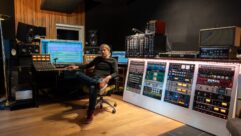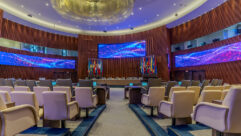HOW DO WE EQUALIZE?: Let me count the ways.
Aug 1, 1998 12:00 PM,
Glen Ballou
Equalization is not the solution to all problems. Before thinking aboutequalizing a sound-reinforcement system, be aware that EQ will never makean improperly designed sound system good. It will probably make mattersworse. Design the system with proper loudspeaker coverage and equal (+/-3dB) sound pressure level (SPL) in the listening area. Only then can EQimprove sound quality and reduce feedback.
Equalization goes back a long way. It appears Dr. Wayne Rudmose was thefirst to perform meaningful EQ (Sound System Engineering, Don and CarolynDavis), but Dr. C. P. Boner was the first to build a user-definable EQ. Dr.Boner equalized systems by making each filter by hand and retesting,changing the filter and testing again. If the system didn’t work, he sentfor loudspeakers with higher directivity until intelligibility wassatisfactory.
Don Davis apprenticed with Dr. Boner, and when Altec introducedAcousta-Voice, Don and Carolyn Davis traveled the country demonstrating andteaching Acousta-Voicing. The filters were passive and required preciseimpedance matching, and instrumentation was designed for lab work ratherthan for equalizing in the field.
Impedance was measured with a General Radio impedance bridge. The testsignal was pink noise (constant power per octave) produced by a GeneralRadio 1382 random noise generator. There were no RTAs (real timeanalyzers); the sound from the loudspeaker/room was measured with a GeneralRadio 1564A sound and vibration analyzer, 1/3 octave at a time. Each 1/3octave was recorded by hand and displayed on graph paper. The filters wereadjusted, and the process repeated until EQ was complete. Another methodwas connecting the pink noise generator to the 1/3 octave filter so only1/3 octave noise was produced. The output of the loudspeaker and room wasrecorded from a sound level meter. The sound system now had to produce onlya narrow frequency range at a time. Adjusting the filter 24 times andrecording the SPL took time. Equipment was AC powered, and EQ was thenoften measured in days or weeks.
I was invited to the first east coast Acousta-Voice demonstration in NewYork in 1968. The evening before the session, I walked into the room justas Don and Carolyn Davis were doing an A-B test with Classical music.Typical of the period, hotel conference room acoustics were poor, and theloudspeakers were not particularly smooth. As Don switched back and forthbetween equalized and unequalized, Carolyn, who has a platinum ear, said”The demonstration is wonderful; everyone will be impressed.” I thought,”No wonder it doesn’t feed back. They removed the highs and lows and gaveit the response of a telephone.” Don switched back to the smooth wide-bandresponse. Carolyn turned to me and said, “Isn’t it wonderful how EQ canmake the sound so smooth and extended?” I had assumed the narrow, poorresponse was the equalized one, but wide frequency response doesn’t causefeedback; it is peaks in the systems, even those with a very narrowbandwidth. Remove the peaks, and feedback is reduced.
Soon, an inexpensive metered RTA was introduced. It consisted of three rowsof eight VU meters laid out exactly like Altec’s Acoustavoice filters. Withthis system, the meters could be seen at one time, and the effects ofmoving the mics or adjusting the filters could be immediately observed. Forthe record, we had to transfer the meter readings onto graph paper.Measurements of 1/3 octave have not changed much even though test equipmenthas become more sophisticated.
Eventually, portable RTAs were produced; the most noticeable was the IVIEIE-30A, which was battery operated and compact. It had two memories,allowing comparison of before with after EQ or one position in the roomwith a second position. The output LEDs gave bar graph output with adisplay range from 15 dB to 45 dB and selectable resolution of 1, 2 or 3dB. The unit could also make octave analysis and was a sound level meter.Portable signal generators were produced, and soon active filters werebeing made.
New instruments can measure 1/6 octave and 1/12 octaves, measure RT60,interface with PCs, have multi-channels, store as many curves as required,compare curves, and measure frequency response at a particular distance,eliminating room effects.
RTAs can measure the characteristics of a room with all of the reflections,but they cannot measure the sound emanating from the loudspeaker withoutthe effects of the room. Fortunately, Dick Heyser invented TDS andsubsequently TEF (time energy frequency), all before we had ICs and DSPs.TEF is still the instrument to which all others are compared. With the TEFmachine, we can measure to a higher frequency resolution than any other way.
In the meantime, Meyer Sound Laboratories came out with the SIM System IIanalyzer. SIM (source independent measurement) allows equalization duringperformances by using the program material as a reference to compute thetransfer function of the hall or speaker system. The system can measurevarious areas in the room by electronically switching between judiciouslyplaced mics.
Gold Line manufactures an MX4 four channel mic multiplexer that averagesthe information from four mics with the resulting curve called “spatiallyaveraged”. This allows you to set up four mics in different locations andmeasure and record the results of each position separately or multiplex allfour together. This may be able to give a better overall EQ to a room thathas less than perfect sound system/room interface. Spatial averaging isrecommended by major film cinema/home theater organizations, includingLucasFilm and Dolby.










